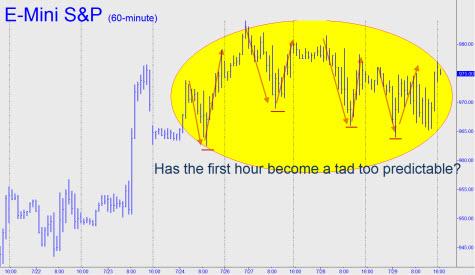The lazy drift of stocks has become almost too boring to watch, although we dare not avert our eyes for fear of missing Wall Street’s next wilding spree. During the last four sessions, the broad averages have hit bottom early in the day after easing lower overnight. In each instance, the Dow Industrials were down about a hundred points before the selling dried up. Then, four hours worth of see-saw action ensued. Finally, in the last hour or so, with bulls and bears alike quite frazzled, shares recouped most of their losses in a flurry of short-covering, settling near their intraday highs. This pattern is shown in the chart below.

Usually, when the stock market’s behavior becomes so repetitious that we see easy opportunity in betting on it, the game changes. And that’s about where we are now – i.e., all but certain that, in order to reap effortless gains today, we need only buy an E-Mini index contract an hour or so into the session, when the Dow is down around a hundred points, and then sell it at a higher price five hours later.
‘Curing’ Greed
So, how might the game change in order to thwart us from making money so very easily as that – or, nearly as likely, cause us to lose our shirts by betting on the obvious? One plausible scenario is that stocks will continue to fall after reaching in the first hour what we — meaning you, I and nearly everyone else — will mistake for the day’s low. That is a common way by which such greedy expectations as we have come to hold are often “cured.” A second, easily imaginable, way would be for stocks to open higher and then continue up, up and away, stranding and confounding the multitudes who had planned to buy the dip. However, we doubt conditions are right for this: shorts are not quite nervous enough, and earnings news not quite bullish enough.
There are of course numerous other ways in which Mr. Market could trick us. But the one thing all of the scenarios we might imagine will be found after-the-fact to have in common is that they will trash our expectations so badly as to cause us to expect almost nothing so confidently once again, at least for a while.
***
Midnight Briefing
There’s good news for traders who were unable to attend the Morning Briefings that Rick held in June before the opening bell. To gauge demand for a late-hours briefing, especially from traders in Europe and Asia, Rick will hold a Midnight Briefing on three successive days next week: Tuesday, Wednesday and Thursday, August 4,5 and 6, starting just after midnight EDT. Click here to sign up.
These 20-minute sessions will begin at 12:01 a.m. EDT (GMT-5:00). During this time, we will attempt to identify timely trading opportunities mainly in the E-Minis and Comex Gold. Last month’s briefings were enormously popular, drawing as many as a thousand traders on some mornings. To reserve a place, register now.
(If you’d like to have Rick’s Picks commentary delivered free each day to your e-mail box, click here.)

The fine detail of today’s innocuous GDP report by way of confirmation of the Matterhorn Report that sending Fed fiat and citizen taxpayer money to Wall Street Corporations disguised as banks accomplished little except planning to build an obsolete GS superstockaccelerator in NJ:
THE FREE FALL
9.0 percent: The rate at which companies cut spending on equipment and software in the second quarter.
36.4 percent: The rate of such spending cuts in the first quarter.
8.9 percent: The rate at which companies cut spending on plants, office buildings and other structures in the second quarter.
43.6 percent: The rate of such spending cuts in the first quarter.
7 percent: The drop in exports in the second quarter.
29.9 percent: The drop in exports in the first quarter.
Add these up and we have a 36.9% drop in exports, a 45.4% drop in equipment and software and a 52.5% drop on spending on plants, office buildings and structures so far in 2009. You would be a TV bubblehead to miss the implosion and implications for gold and other assets including stocks…
And here’s the GDP bottom line if we do the simple addition:
THE BIG PICTURE
1.0 percent: The annual rate at which GDP dropped in the second quarter.
6.4 percent: The rate of GDP decline in the first quarter.
5.4 percent: The rate of GDP decline in the fourth quarter of 2008.
2.7 percent: The rate of GDP decline in the third quarter of 2008.
In the last 4 Quarters, GDP declined -15.5% if you believe official revisions, a textbook definition of Depression.
Maybe some brave traders will figure this out over the weekend…